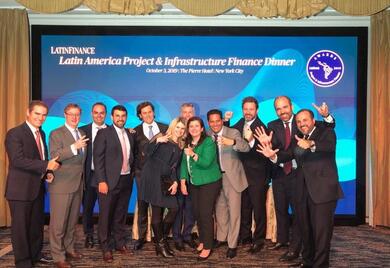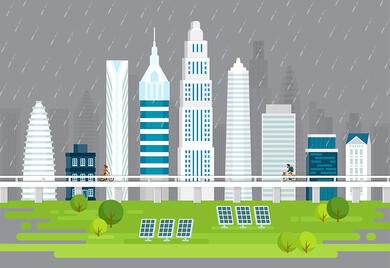Posts by Transport

Five Posts to Recap 2019 Ahead of 2020
We’ve selected five articles from the Negocios Sostenibles (Sustainable Business) blog to form a picture of the innovation and challenges that took place this past year. Together, they provide a general viewpoint for 2020 as we begin the year ahead.

Six LatinFinance 2019 Awards Recognizing IDB Invest's Efforts
LatinFinance magazine has selected six IDB Invest projects among the year's best, lauding the organization’s commitment with the private sector in Latin America and the Caribbean.

Here’s one example of how Big Data helps transportation in our region
Waze helps us navigate traffic and save precious time. In partnership with the IDB Group, it’s also helping to measure the impact of transport projects and solve related challenges in Latin America and the Caribbean.

Latin-America and the Caribbean are surfing the ride-hailing wave
Remember what trying to get a cab used to be like? Not long ago, you would have to step into the street, wave your arm in hopes of being noticed and sometimes wrestle another would-be passenger for the coveted spot. And that was only the beginning. At times, cab drivers took you down the “tourist route,” or simply got lost finding their way. At pay time, it was a matter of luck for you to have cash or for a driver to have change.

Shared value takes off
The airport industry is key to the growth of air travel in Latin America. This industry generates 5.2 million jobs that add $167,000 million to the region’s gross domestic product annually. Projections indicate that during the next 20 years this industry will create 99 million jobs around the world. For example in Quito the Mariscal Sucre International Airport was built in 2013 as a private undertaking that, with the IDB Group support, would play a strategic role for this industry in the region. However, modern airports are much more than air transport terminals. They have become “development hubs where other air transport-related or complementary activities converge”, as we have already discussed. A ticket to local food It is increasingly evident that more airport operators and investors realize that environmental and social sustainability has become an investment opportunity that makes financial sense, generating significant benefits for sustainable development. Quiport S.A. — the private operator of the Quito airport — has not been an exception to the rule, and they approached us with a challenge in mind: how to share the value of this development with the local community? The first step was to support the company in conducting a shared value assessment, which allowed us to determine the current and potential resources available. Based on this analysis, Quiport decided to focus on three initiatives to improve both the company and community sustainability by establishing a community-based recycling organization, creating an aviation training center, and supporting the program development of Nuestra Huerta, helping local food producers to be involved in the airport activities. Over the last two years, IDB Invest has supported Nuestra Huerta with business, marketing, and execution trainings, including orientation regarding legal permits for food vending. Thus, the cooperative went from selling fruits and vegetables on a weekly basis to only 100 direct employees of Quiport, to selling more than 36 products to the 7,500 airport workers. Growth has been such that an online platform was created to place orders. Today, this program has benefited not only farmers, but also airport workers who can purchase fruits and vegetables in their workplace. Furthermore, Nuestra Huerta expects to open a store in the airport to sell their product to tourists. Shared value, multiplying effect on profits The Quiport project clearly shows that, in addition to any efforts and work aimed at including the community for the sake of sustainability, one of the most significant outcomes from this project are seen in the company´s positive bottom line. Even though it was not an initial project goal, the upcoming opening of a Nuestra Huerta store will generate a modest return for the airport. Currently, the company is developing recycling initiatives and an aviation training center. The recycling effort will allow the company to save in waste disposal costs, and generate some marginal income from the sale of recyclable materials. As for the training center, customer service will improve at the airport. IDB Invest is committed to working with the private sector to foster sustainable development in Latin America and the Caribbean. We seek investment opportunities that will bring about benefits to communities and companies, as we have done with the shared value assessment for the Quito project. It is not always easy to identify these opportunities, and it is even more challenging to move them forward, but Quiport is a good example that every effort has its reward. So, how do you share the value of your company? Subscribe to receive more content like this! [mc4wp_form]

Four challenges facing the buildings of the future
In the 1960s, the Jetsons showed us a futuristic city in which pollution and the use of non-renewable resources did not exist. Twenty years later, when we had already begun to hear about environmental problems, Blade Runner showed us a more pessimistic vision of 2019: a city with countless skyscrapers, over-population, and extremely high pollution levels. Today we already have much of the Jetson’s smart technology, but sustainable buildings are needed to avoid Ridley Scott’s dystopian city. In 2016, the New Climate Economy determined that the only way to grow in the future and address the current gap is with sustainable infrastructure. According to the Inter-American Development Bank (IDB) and Mercer study “Crossing the Bridge to Sustainable Infrastructure Investing. Exploring Ways to Make it Across,” the ability to develop buildings of this kind depends on overcoming at least four key challenges: 1. Lack of familiarity What is sustainable infrastructure? Many investors still lack the information they need to clearly identify what it is and what it is not, and to identify the nature of the business opportunity. This makes it difficult to increase this type of construction. Sustainable infrastructure is planned, constructed, and operated to comply with changing governance, social, environmental, economic, and financial standards over time. For this reason, the role of multilateral and governmental organizations is to educate, inform, and provide appropriate financial products, in order to adapt current businesses to a climate change resilient economy with low carbon emissions. 2. Limited standardization of tools and approaches As this is a megatrend in full swing, there is excessive fragmentation in sustainability standards, principles, and initiatives. In addition, there is a lack of adequate information available on what the environmental, social, and governance criteria are for companies not listed in their respective securities markets, making it difficult for investors to identify which projects are sustainable. In addition, the lack of information increases transaction costs. For this reason, the IDB Group is developing and promoting the adoption of harmonized principles and working with investors to facilitate discussions regarding currently existing barriers to sustainable infrastructure. The objective is to generate useful solutions with innovative financial instruments in local markets and public-private partnerships and concessions that facilitate private sector participation. [clickToTweet tweet="US$6 trillion investment in sustainable infrastructure per year requires #Latam and the #Caribbean" quote="US$6 trillion investment in sustainable infrastructure per year requires Latin America and the Caribbean" theme="style1"] 3. Lack of coordinated policy Another fundamental point is to have consistent regulations and a commitment to comply with them throughout the region and in all sectors. Following guidelines like the Paris Agreement and the United Nations Sustainable Development Goals is key to maintaining investors’ interest in measures such as the adoption of clean energy. For Latin America and the Caribbean, it is essential to adopt instruments adapted to our reality. In this case, the IDB Group’s NDC Invest is a solution enabling countries to implement these guidelines through a simple platform for preparing sustainable and bankable project portfolios, and increasing access to concessional funds, among other benefits. 4. Lack of tools and focus on climate resilience To date, priority has not been given to how climate change adaptation should be achieved, both in terms of infrastructure and the financial tools for investing in it. However, today there are various financial tools for adapting to climate change. For example, IDB Invest (formerly known as Inter-American Investment Corporation) has mixed climate financing instruments that can be used to address these challenges and adopt climate change resilient modalities with low carbon emissions. Developing the construction of the future requires investing at least US$6 trillion per year in sustainable infrastructure for our region. This will make it possible to support the economic development of Latin America and the Caribbean, grow at the necessary pace, and prevent our cities from becoming futuristic dystopias. Subscribe to receive more content like this! [mc4wp_form]
